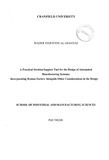JavaScript is disabled for your browser. Some features of this site may not work without it.
| dc.contributor.advisor | Greenough, Richard | |
| dc.contributor.advisor | Kay, John M. | |
| dc.contributor.author | Al-Mannai, Bader Darwish | |
| dc.date.accessioned | 2022-12-07T11:05:42Z | |
| dc.date.available | 2022-12-07T11:05:42Z | |
| dc.date.issued | 2005-09 | |
| dc.identifier.uri | https://dspace.lib.cranfield.ac.uk/handle/1826/18763 | |
| dc.description.abstract | The way in which a manufacturing system is designed is a crucial determinant of its ability to meet the current competitive challenges. The existing literature and research findings draw attention to the importance of addressing human factors in the design of the manufacturing systems to face these challenges. However, the evidence gathered from the literature clearly illustrates that organisations are not fully incorporating human factors (macro- and micro-ergonomics) in the design of manufacturing systems. In addition, the current system design practices tend to relegate ergonomics evaluation to post-design, leaving ergonomists little opportunity to make significant and important changes. This thesis details a study which investigates the role of human factors in manufacturing systems design and how it can be integrated into automated manufacturing decision-making. Focus is given to the area of manufacturing automation selection within workstation and cell design. The aim of this research is to support manufacturing systems designers to better incorporate human factors in manufacturing systems design. A research programme has been designed to fulfil this aim. It consisted of three phases: industrial survey, decision support tool formulation, and practical evaluation. The first phase involved conducting interviews with leading manufacturing organisations in the United Kingdom to determine the work practice in industry and the need for' improvements. The second phase comprised the design and development of the decision support tool in a workbook and software application. The final phase was the evaluation of the tool in collaboration with industry. Overall the outcome of this research was a novel structured approach that deploys both the Quality Function Deployment and Failure Mode and Effect Analysis methods to incorporate human factors alongside technical, organisational, and economical factors in the decision-making process of manufacturing systems design, thereby allowing the consideration of human factors at the feasibility study stage. | en_UK |
| dc.language.iso | en | en_UK |
| dc.rights | CC0 1.0 Universal | * |
| dc.rights.uri | http://creativecommons.org/publicdomain/zero/1.0/ | * |
| dc.title | A Practical Decision Support Tool for the Design of Automated Manufacturing Systems: Incorporating Human Factors Alongside Other Considerations in the Design | en_UK |
| dc.type | Thesis | en_UK |
Files in this item
The following license files are associated with this item:

